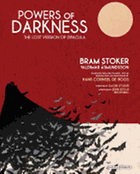
In 1901, Valdimar Ásmundsson published Makt Myrkanna (or Powers of Darkness), an Icelandic translation of Bram Stoker's popular gothic novel, Dracula. Stoker approved of the translation, collaborating with Ásmundsson on his efforts and providing an author's note to appear in the original edition. In 2014, Hans De Roos set out to translate Ásmundsson's Icelandic tale back into English--and was astonished to find that Powers of Darkness was not merely a translation of Stoker's classic novel, but rather an entirely new adaptation of the story. Large swaths of Stoker's original text had been removed or modified, resulting in a tightened version of Dracula that more fully drives home the terror of the infamous monster.
Powers of Darkness follows Stoker's original outline in many ways, using Harker's journal entries to convey the terrors of Count Dracula's castle, and following a similar timeline and cast of characters. But Stoker and Ásmundsson's adaptation draws heavily on both Norse mythology and aspects of the Icelandic language as well, changing the original story in subtle and fascinating ways. These alterations are expertly highlighted throughout the text in De Roos's detailed and explicit annotations, which provide linguistic, cultural and historical context for the revisions made to the original Dracula. With a foreword by Dacre Stoker, a descendant of Bram, and an afterword by Dracula expert John Edgar Browning, Powers of Darkness is a delight to read as a classic tale of horror and fear, and as a fascinating look at the role of translation in the interpretation and understanding of classic literature. --Kerry McHugh, blogger at Entomology of a Bookworm

